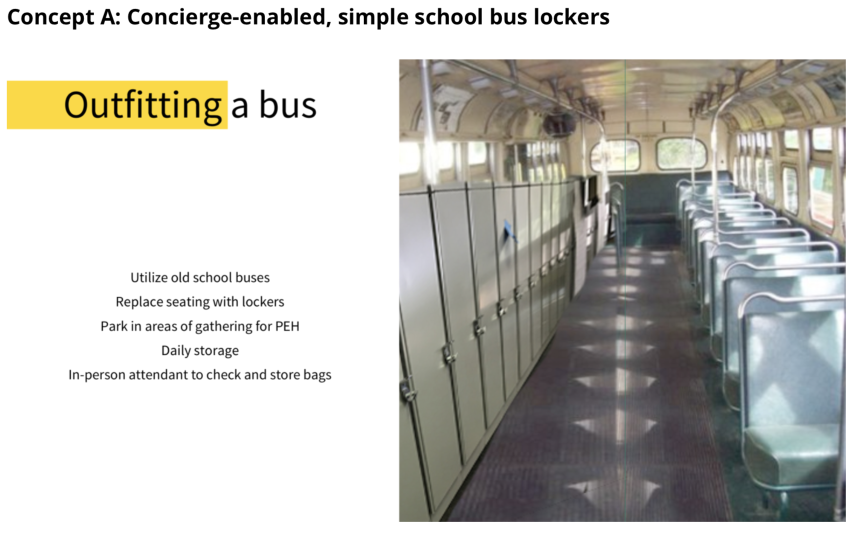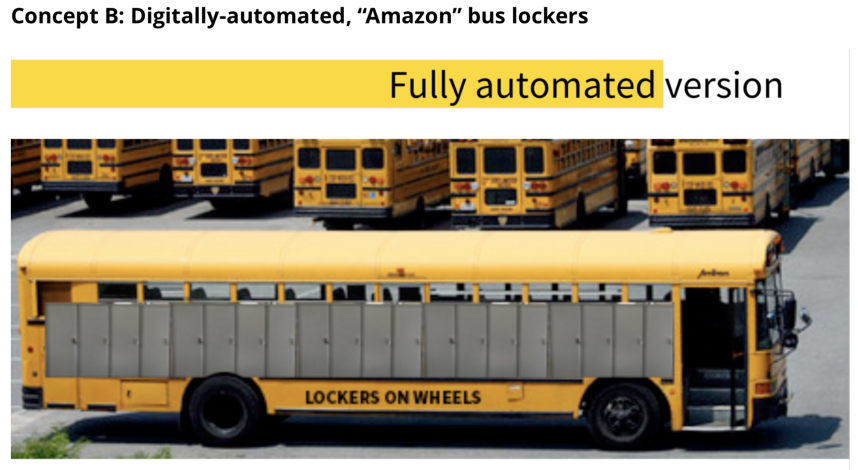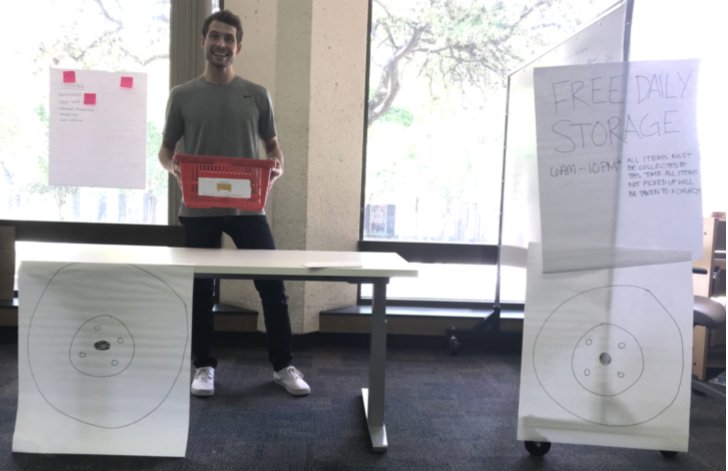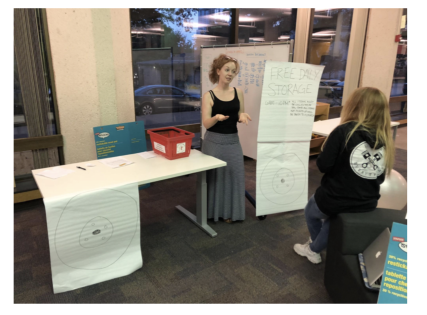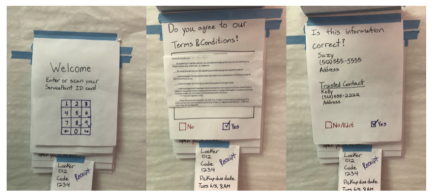Designing for dignity, homelessness and resilience in the city of Austin
Each year thousands of Austinites find themselves without a home, and are often left with the burden of carrying everything they own on the street.
Many essential public services, such as the Department of Human Services, city hospitals, and the Austin Public Library, do not allow patrons to enter with shopping carts or bedrolls due to fear of bed bug infestation—a major risk to health codes which incur costly fines. Bringing these to job interviews is also not an option, and in many cases, belongings are hidden in bushy areas, downtown alleys, and in the city outskirts. Contrary to popular myths about the homeless, there are many people experiencing homelessness (PEH) who do find access to employment (Homelessness Myths, 2018). However, the burden of carrying their belongings and the fear and stigma associated with their status makes it difficult to gain or keep a job.
Wherein the cost of emergency healthcare for PEH averages an estimated $50,000 per year per person in Austin (Austintexas.gov, 2018), the homelessness epidemic in America continues to bloat an increasingly frayed healthcare and public services system. This is not ideal for the public— who funds such programs— or the PEH, who are a constant target for theft, violence, and at high risk for further relapsing upon the trauma of lost belongings and vital documentation.
This project researched the issue of homelessness in Austin, Texas, and the inflection point of physical storage in the life of people experiencing homelessness (PEH). The purpose of this project was to enhance the knowledge base of Austin’s homeless services ecosystem and to demonstrate how human-centered design (HCD) may be applied to promote the equitable, compassionate, and dignified treatment of the city's citizens in the development of user-centered products and services.
The following are excerpts from Designing for dignity, homelessness and storage in the city of Austin: How might we secure street living and promote resilient recovery? (2018)
Tags: City of Austin, People Experiencing Homelessness, Service Design, Service Prototyping, Civic Design, Public-Interest Design, Participatory Design, Social Design, Self-Determination Theory, Mechanisms of Change
Roles: Lead Design Researcher, Strategist, User Researcher, Service Designer
Partners: Hyper Island, City of Austin Office of Design, Technology, and Innovation, Service Design ATX, Bloomberg Philanthropies
Source: Austin Chronicle (2018)
“While people experiencing homelessness understand the challenges of homelessness first-hand, their voices are rarely considered in policy making and are often marginalized in communities. By actively involving PEH and those responsible for delivering services into the creation of policies and programs, we reverse the typical top-down approach and begin with those on the receiving end of a system.”
UPDATE: In winter 2019/2020 $6.5 million of funding was approved by City Council and allocated by Austin Resource Recovery to build more than 500 transitional storage spaces for people experience homelessness. In 2020 construction began in response to this project and a new Homeless Services Division was created within Austin Public Health.
Research Questions & Human-Centered Design Process:
British Design Council Double Diamond Model of Human-Centered Design, Rendering by Dan Nessler
How can design be used to inform and create socially impactful products and services?
How might a systems view on homelessness inform and frame strategic
interventions?
How might the involvement of multiple types of public stakeholders, including people with lived experience of homelessness, shape the design of solutions?
What are effective contexts (culture, language, actors, locations, format, time, etc.) for an impactful solution to exist? What are the peripheral and contextual needs/risks/restrictions that may affect the success of a solution?
How might a service intervention respect the rights of vulnerable people and improve quality of life for its users?
Photo consent obtained
Domain and Human Research
To establish preliminary and ongoing domain understanding, secondary research on literature relating to the topics of homelessness, service design, social impact design, systems thinking and data specific to the City of Austin was reviewed. Given the specificity of homelessness issues as it relates to local context, expert interviews were conducted with key professionals actively engaged with Austin’s homeless services ecosystem. To better understand the motivations, needs, and goals of PEH and their experiences related to storing and transporting belongings in Austin, ethnographic interviews were conducted in-person and on-site at key areas of gathering for the homeless. The study reflects the generative user research synthesis of in-depth, semi-structured qualitative interviews and written surveys from PEH with context to storing and transporting belongings. To supplement the attitudinal data from interviews and surveys, observational research was also conducted to facilitate a realistic understanding of the way users interact and behave within context. Field research was conducted in downtown Austin, at the Austin Resource Center for Homeless, Trinity Center, at Austin Public Libraries, and Challenger Newspaper meetings. The ethnographic research framework AEIOU (Activities, Environments, Interactions, Objects and Users) was applied via low-fidelity notetaking to focus open-ended observations into factual and objective data.
Ideation & Prototyping
To get creative and build upon the themes and insights from research, a multi-day participatory design workshop which involved key organizational stakeholders, people with lived experience of homelessness, and members of the public was held in Austin, Texas. The goals of the workshop were to (1) share and align on major issues of homelessness in Austin with citizens and stakeholders, and (2) ideate, prototype, and test potential solutions with affected users of the system. By involving a diverse set of perspectives in the alignment of problem areas and generation of solutions, a multitude of ideas could be proposed and mutually evaluated from the different angles of the service ecosystem.
Public Services currently prioritizes only the most severe cases amongst the vulnerable– what about everyone else?
The concept of a mobile, short-term storage locker service was proposed for further exploration and development. Dissection of the concept’s potential manifestation gave rise to several questions, underlying assumptions and overarching concerns, including:
How will we ensure stored belongings aren’t dangerous or used for criminal activity? How do people prove ownership of their items? What happens to items that are not picked up? What hours would the service operate? How long would people need or want to store their items? How will people locate the busses? How will they keep track of them? Can/will PEH pay for lockers? How much are people (in general) willing to pay? How will people trust the service?
With the above questions in mind, two distinct manifestations of the concept rose, and each was further developed and tested with PEH through the use of rapid service prototyping, process bodystorming, and lo-fi paper prototyping:
Read the in-depth report: Designing for dignity, homelessness and storage in the city of Austin (2018)
Includes full abstract, introduction, methodology, ethics code, theoretical foundation, literature review, user research, synthesis, ideation, concept development, risks and trade-offs analysis, A/B service prototyping, key observations, user and expert feedback, iterative adjustments, design recommendations, discussion, limitations, conclusion, and artifact appendix.









